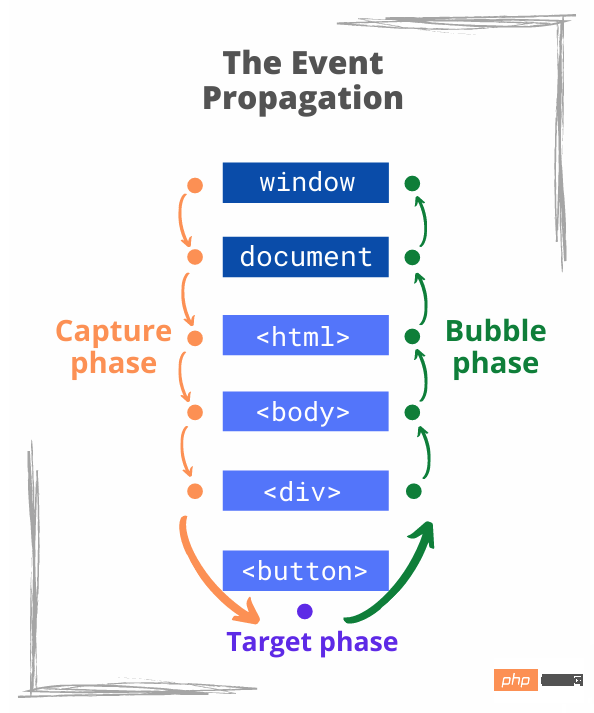An in-depth analysis of event delegation in JS

Why do we need to perform event delegation?
First implement a small function: after clicking the HTML button, output the message to the console.
In order to implement this small function, you need to select the button, and then use the addEventListener() method to attach an event listener:
<button id="buttonId">Click me</button>
<script>
document.getElementById('buttonId')
.addEventListener('click', () => console.log('Clicked!'));
</script>The above is to listen to a single element ( Especially the way events are done on buttons).
What if you need to listen to events on multiple buttons? Here's a possible implementation:
<div id="buttons">
<button class="buttonClass">Click me</button>
<button class="buttonClass">Click me</button>
<!-- buttons... -->
<button class="buttonClass">Click me</button>
</div>
<script>
const buttons = document.getElementsByClassName('buttonClass');
for (const button of buttons) {
button.addEventListener('click', () => console.log('Clicked!'));
}
</script>You can see how it works on Codesandbox.
The button list is iterated as for (const button of buttons) and a new listener is attached to each button. In addition, after buttons are added or removed from the list, you must also manually remove or attach event listeners.
Is there a better way?
Fortunately, if we use the "event delegation" pattern, listening to events on multiple elements only requires one event listener.
Details of the event propagation mechanism used by event delegation. To understand how event delegation works, you should first understand what event propagation is.
Event propagation
When you click the button in the html below:
<html>
<body>
<div id="buttons">
<button class="buttonClass">Click me</button>
</div>
</body>
</html>How many elements will the click event fire? No doubt the button itself receives the click event. And all button ancestors, even document and window objects will also be received.
The propagation of click events is divided into three stages:
Capture stage —— From
window,documentStarting with the root element, the event propagates down to the ancestors of the target elementTarget phase - The event is triggered on the element clicked by the user
Bubbling Phase - Finally, the event bubbles through the ancestors of the target element, all the way to the root elements
documentandwindow.

addEventListener The third parameter of the methodcaptureOrOptions :
element.addEventListener(eventType, handler[, captureOrOptions]);
enables you to capture events from different stages.
- The listener will capture # if the
captureOrOptionsparameter is missing or isfalseor{capture:false}##Events of target and bubble phases If the parameter is - true
or{capture: true}, then detect The listener will listen forcapture phase events.
element: document.body.addEventListener('click', () => {
console.log('Body click event in capture phase');
}, true);, you can see how the event propagates in the console when you click the button. So how does event propagation help capture multiple button events?
The algorithm is simple: Attach an event listener to the button's parent and capture the bubbling event when the button is clicked. This is how event delegation works.
3. Event Delegate
Let’s use event delegation to capture clicks on multiple buttons:
<div id="buttons"> <!-- Step 1 -->
<button class="buttonClass">Click me</button>
<button class="buttonClass">Click me</button>
<!-- buttons... -->
<button class="buttonClass">Click me</button>
</div>
<script>
document.getElementById('buttons')
.addEventListener('click', event => { // Step 2
if (event.target.className === 'buttonClass') { // Step 3
console.log('Click!');
}
});
</script>Open the
Codesandbox demo and click Any button, you will see 'Click!' message is logged to the console. The idea of event delegation is very simple. You don't need to attach the delegate event listener directly to the button. Instead, you can delegate the parent listener
The above is the detailed content of An in-depth analysis of event delegation in JS. For more information, please follow other related articles on the PHP Chinese website!

Hot AI Tools

Undresser.AI Undress
AI-powered app for creating realistic nude photos

AI Clothes Remover
Online AI tool for removing clothes from photos.

Undress AI Tool
Undress images for free

Clothoff.io
AI clothes remover

AI Hentai Generator
Generate AI Hentai for free.

Hot Article

Hot Tools

Notepad++7.3.1
Easy-to-use and free code editor

SublimeText3 Chinese version
Chinese version, very easy to use

Zend Studio 13.0.1
Powerful PHP integrated development environment

Dreamweaver CS6
Visual web development tools

SublimeText3 Mac version
God-level code editing software (SublimeText3)

Hot Topics
 1377
1377
 52
52
 How to implement an online speech recognition system using WebSocket and JavaScript
Dec 17, 2023 pm 02:54 PM
How to implement an online speech recognition system using WebSocket and JavaScript
Dec 17, 2023 pm 02:54 PM
How to use WebSocket and JavaScript to implement an online speech recognition system Introduction: With the continuous development of technology, speech recognition technology has become an important part of the field of artificial intelligence. The online speech recognition system based on WebSocket and JavaScript has the characteristics of low latency, real-time and cross-platform, and has become a widely used solution. This article will introduce how to use WebSocket and JavaScript to implement an online speech recognition system.
 WebSocket and JavaScript: key technologies for implementing real-time monitoring systems
Dec 17, 2023 pm 05:30 PM
WebSocket and JavaScript: key technologies for implementing real-time monitoring systems
Dec 17, 2023 pm 05:30 PM
WebSocket and JavaScript: Key technologies for realizing real-time monitoring systems Introduction: With the rapid development of Internet technology, real-time monitoring systems have been widely used in various fields. One of the key technologies to achieve real-time monitoring is the combination of WebSocket and JavaScript. This article will introduce the application of WebSocket and JavaScript in real-time monitoring systems, give code examples, and explain their implementation principles in detail. 1. WebSocket technology
 How to use JavaScript and WebSocket to implement a real-time online ordering system
Dec 17, 2023 pm 12:09 PM
How to use JavaScript and WebSocket to implement a real-time online ordering system
Dec 17, 2023 pm 12:09 PM
Introduction to how to use JavaScript and WebSocket to implement a real-time online ordering system: With the popularity of the Internet and the advancement of technology, more and more restaurants have begun to provide online ordering services. In order to implement a real-time online ordering system, we can use JavaScript and WebSocket technology. WebSocket is a full-duplex communication protocol based on the TCP protocol, which can realize real-time two-way communication between the client and the server. In the real-time online ordering system, when the user selects dishes and places an order
 How to implement an online reservation system using WebSocket and JavaScript
Dec 17, 2023 am 09:39 AM
How to implement an online reservation system using WebSocket and JavaScript
Dec 17, 2023 am 09:39 AM
How to use WebSocket and JavaScript to implement an online reservation system. In today's digital era, more and more businesses and services need to provide online reservation functions. It is crucial to implement an efficient and real-time online reservation system. This article will introduce how to use WebSocket and JavaScript to implement an online reservation system, and provide specific code examples. 1. What is WebSocket? WebSocket is a full-duplex method on a single TCP connection.
 JavaScript and WebSocket: Building an efficient real-time weather forecasting system
Dec 17, 2023 pm 05:13 PM
JavaScript and WebSocket: Building an efficient real-time weather forecasting system
Dec 17, 2023 pm 05:13 PM
JavaScript and WebSocket: Building an efficient real-time weather forecast system Introduction: Today, the accuracy of weather forecasts is of great significance to daily life and decision-making. As technology develops, we can provide more accurate and reliable weather forecasts by obtaining weather data in real time. In this article, we will learn how to use JavaScript and WebSocket technology to build an efficient real-time weather forecast system. This article will demonstrate the implementation process through specific code examples. We
 How to use insertBefore in javascript
Nov 24, 2023 am 11:56 AM
How to use insertBefore in javascript
Nov 24, 2023 am 11:56 AM
Usage: In JavaScript, the insertBefore() method is used to insert a new node in the DOM tree. This method requires two parameters: the new node to be inserted and the reference node (that is, the node where the new node will be inserted).
 Simple JavaScript Tutorial: How to Get HTTP Status Code
Jan 05, 2024 pm 06:08 PM
Simple JavaScript Tutorial: How to Get HTTP Status Code
Jan 05, 2024 pm 06:08 PM
JavaScript tutorial: How to get HTTP status code, specific code examples are required. Preface: In web development, data interaction with the server is often involved. When communicating with the server, we often need to obtain the returned HTTP status code to determine whether the operation is successful, and perform corresponding processing based on different status codes. This article will teach you how to use JavaScript to obtain HTTP status codes and provide some practical code examples. Using XMLHttpRequest
 How to get HTTP status code in JavaScript the easy way
Jan 05, 2024 pm 01:37 PM
How to get HTTP status code in JavaScript the easy way
Jan 05, 2024 pm 01:37 PM
Introduction to the method of obtaining HTTP status code in JavaScript: In front-end development, we often need to deal with the interaction with the back-end interface, and HTTP status code is a very important part of it. Understanding and obtaining HTTP status codes helps us better handle the data returned by the interface. This article will introduce how to use JavaScript to obtain HTTP status codes and provide specific code examples. 1. What is HTTP status code? HTTP status code means that when the browser initiates a request to the server, the service





